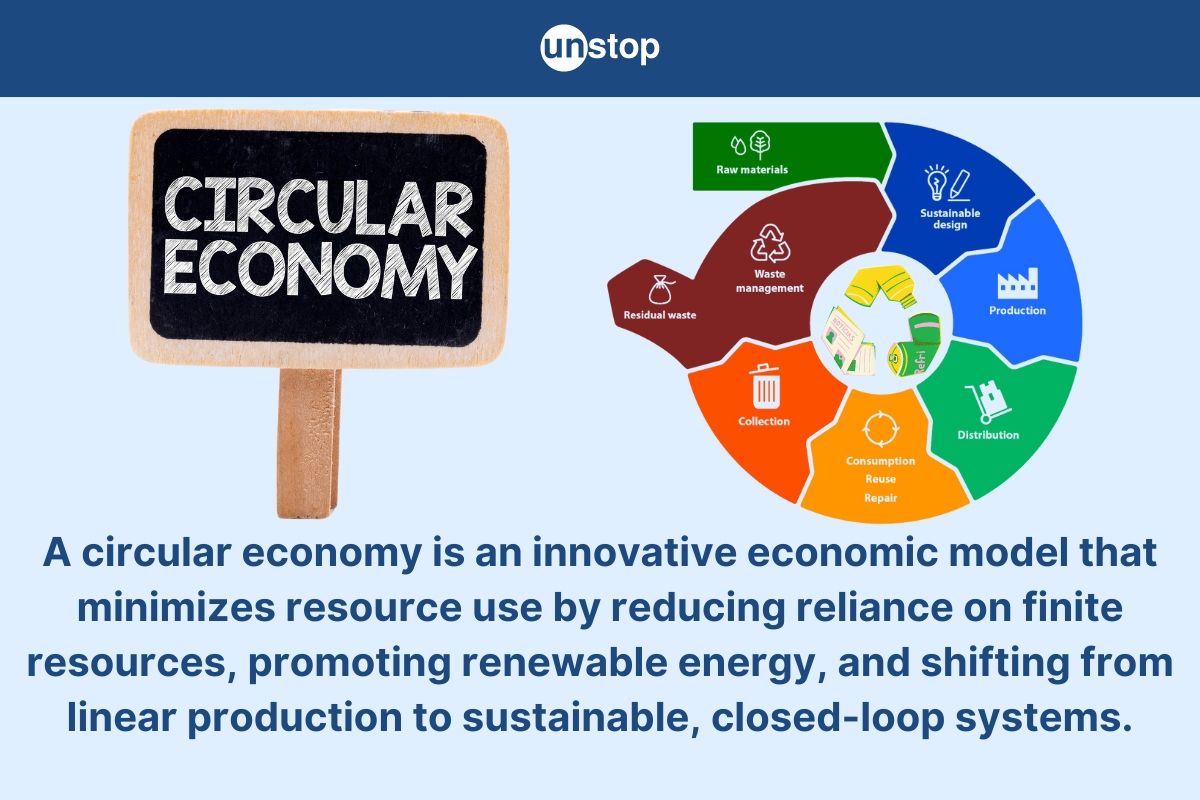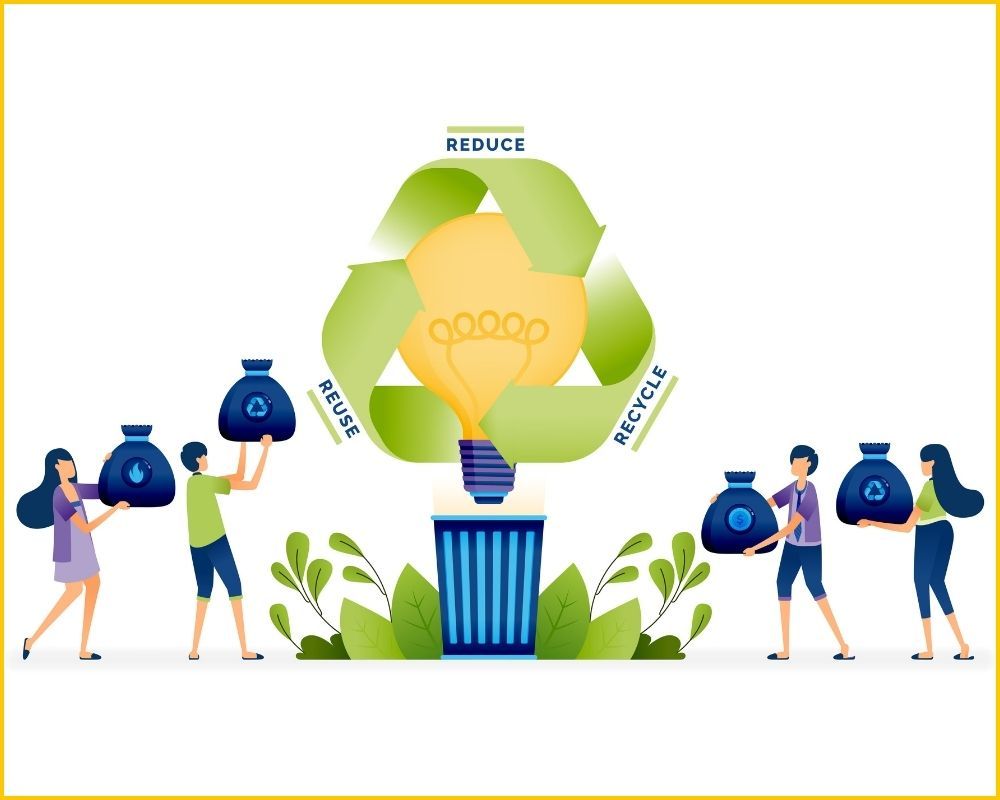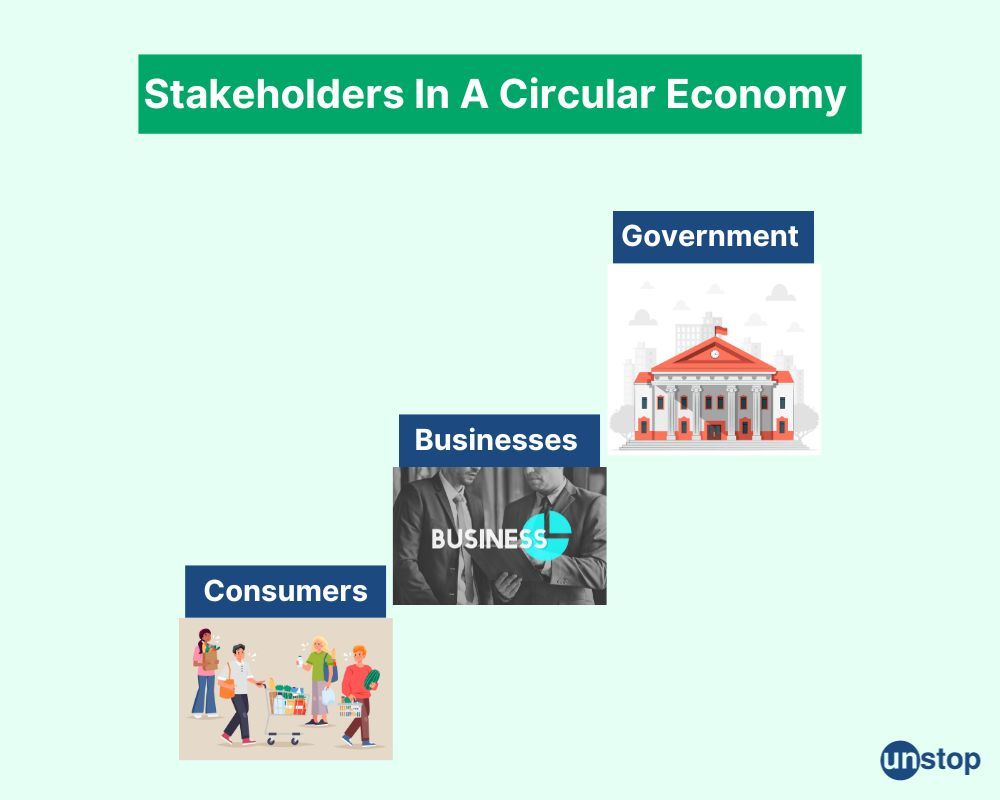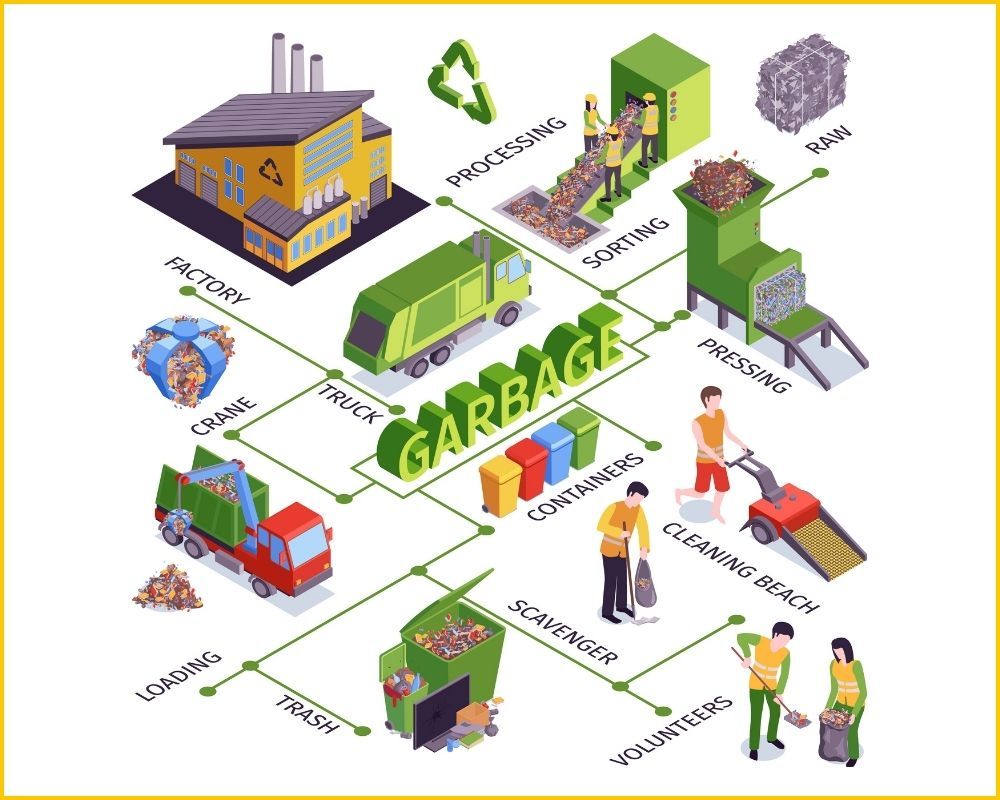- What is a Circular Economy?
- Principles of a Circular Economy
- How to implement a Circular Economy?
- Benefits of a Circular Economy
- What are the Challenges of a Circular Economy?
- Examples of a Circular Economy
- Conclusion
- Frequently Asked Questions (FAQs)
What is a Circular Economy? Definition, Principle, Benefit & Example

The concept of a circular economy is rapidly gaining traction worldwide. Its main focus is to reduce waste and promote sustainability, representing a shift in mindset and practices towards a more efficient and regenerative economic system. This innovative approach aims to minimize resource extraction, maximize product lifespan, and encourage the reuse and recycling of materials.
Transitioning to a circular economy presents numerous opportunities for industries across various sectors. Apart from reducing environmental impact, businesses can also benefit from cost savings and increased competitiveness by adopting a circular economy.
What is a Circular Economy?
A circular economy is an economic model designed to minimize waste and make the most of resources. Unlike the traditional linear economy, which follows a "take-make-dispose" approach, the circular economy aims to close the loop by reusing, recycling, and regenerating materials in production and consumption processes.
This approach keeps resources in use for as long as possible, extracts the maximum value from them, and recovers and regenerates products at the end of their service life.
At its core, a circular economy aims to reduce the dependency of human needs on finite resources and strive for the use of renewable resources. This means finding ways to minimize the consumption of materials that cannot be replenished or take a significant amount of time to regenerate.
By doing so, we can ensure that these resources are available for future generations. To achieve this, businesses and individuals need to adopt innovative practices such as recycling, reusing, and repurposing materials.

Image credit: Freepik
Instead of discarding items after a single use, they can be repaired or refurbished to extend their lifespan. This approach not only conserves valuable resources but also reduces waste going into landfills.
Principles of a Circular Economy
The circular economy is built on three core principles designed to maximize efficiency and sustainability:
-
Design Out Waste and Pollution:
- Products and systems are designed to prevent waste generation at every stage.
- Examples include sustainable packaging, modular design, and biodegradable materials.
-
Keep Products and Materials in Use:
- Emphasizes extending the life cycle of products through reuse, refurbishing, remanufacturing, and recycling.
- Encourages a "product as a service" model, where consumers lease or share products instead of owning them.
-
Regenerate Natural Systems:
- Focuses on using renewable resources and supporting regenerative agriculture and sustainable energy sources.
- Restorative practices help maintain ecosystem balance and avoid resource depletion.
| Principle | Description | Example |
|---|---|---|
| Design Out Waste & Pollution | Prevents waste creation by designing products and processes to avoid waste | Sustainable packaging, eco-friendly materials |
| Keep Products in Use | Extends product lifecycles by reusing, repairing, and recycling | Car-sharing, refurbishing electronics |
| Regenerate Natural Systems | Uses renewable resources and supports the restoration of ecosystems | Renewable energy, regenerative agriculture |
How to implement a Circular Economy?
To effectively implement a circular economy, three crucial stakeholders play a crucial role namely governments, businesses, and consumers.

Let's explore how each of these stakeholders contributes to the transitioning process towards a circular economic model.
Governments
The role of government is indispensable in driving the adoption of circular business models by implementing policies that support sustainability and resource efficiency.
Promote recycling initiatives: Governments can establish robust recycling programs and provide incentives for businesses to adopt recycling practices. This helps reduce waste sent to landfills and conserves valuable resources.
Encourage cleaner production: By setting regulations and standards for cleaner production methods, governments can promote sustainable manufacturing processes that minimize waste generation and reduce environmental impact.
Support research and development: Governments can provide funding or grants to support projects, research, and development, enabling the discovery of innovative technologies that facilitate the transition towards a circular economy.
Businesses
Businesses have a significant role in implementing circular practices within their operations. They can implement the following ideas:
Redesign products: Adopting product redesign strategies allows companies to make products that are durable, repairable, recyclable, or made from recycled materials. This extends the lifespan of products and reduces waste.
Implement reverse logistics: By establishing efficient reverse logistics systems, businesses can collect used products from consumers for repair, refurbishment, or recycling. This helps close the loop by ensuring resources are reused instead of being discarded.
Optimize supply chains: Businesses can work towards creating closed-loop supply chains by sourcing materials sustainably, reducing waste throughout the production process, and collaborating with suppliers who embrace circularity.
Consumers
Educating consumers about the benefits of sustainable consumption is essential for encouraging their participation in circular practices. Here's how it can be achieved:
Raise awareness through campaigns: Education and awareness campaigns can inform consumers about the importance of reducing waste, recycling, and making conscious purchasing decisions. These initiatives can inspire individuals to adopt more sustainable consumption patterns.
Encourage reuse and repair: Consumers can contribute to a circular economy by opting for reusable products, repairing items instead of replacing them, and donating or selling unwanted goods instead of throwing them away.
Reduce food waste: Food waste is a major issue that contributes to environmental degradation. Consumers can help combat this problem by planning meals effectively, storing food properly, and supporting initiatives that redistribute surplus food to those in need.
By working together, governments, businesses, and consumers can drive the transition towards a circular economy. This collective effort will lead us toward a more resource-efficient and environmentally sustainable future.
Benefits of a Circular Economy
A circular economy brings several benefits that go beyond just reducing waste. Here are some key benefits:
Environmental Conservation: By minimizing resource extraction and reducing waste, the circular economy helps protect our planet's natural resources and ecosystems.
Resource Efficiency: The circular economy maximizes the value we get from materials by keeping them in use for as long as possible, reducing the need for constant production.
Cost Savings: Repairing or reusing items can be more cost-effective than constantly buying new ones. This benefits both individuals and businesses.
Economic Growth: The circular economy has the potential to drive economic growth by creating new business opportunities in areas such as recycling technologies, repair services, and sustainable manufacturing.
Job Creation: Shifting towards a circular economy can generate employment opportunities across various sectors involved in activities like recycling, refurbishing, and eco-design.
Resilience: The circular economy enhances the resilience of our systems by reducing dependence on finite resources and minimizing supply chain vulnerabilities.
Resource For Future Generations: By making sure that resources are used efficiently and effectively throughout their lifespan, we can secure their availability for future generations.
What are the Challenges of a Circular Economy?
While a circular economy presents numerous benefits, it is not without its challenges:
Transitioning from Linear to Circular: Moving from a linear economy to a circular economy requires significant changes in mindset, business models, and infrastructure. This transition may pose challenges for industries accustomed to the traditional linear approach.
Complex Value Chains: Implementing circular practices often involves multiple stakeholders across complex value chains. Collaboration and coordination among these actors are crucial for successful implementation.
Consumer Behavior: Shifting consumer behavior towards more sustainable consumption patterns can be challenging. Nevertheless, education and awareness campaigns can play a vital role in driving this change.
Examples of a Circular Economy
Circular economy initiatives come in various forms, each contributing to the goal of reducing waste and promoting sustainability. Let's explore some examples of how businesses and organizations are implementing circular economy principles.
Textile Recycling Programs
One example of a circular economy initiative is textile recycling programs. These programs aim to divert textiles from ending up in landfills by collecting and repurposing them. Instead of throwing away old clothes or fabrics, they can be recycled into new products or transformed into raw materials for other industries.

Image credit: Freepik
Textile recycling not only reduces waste but also conserves resources like water and energy that would otherwise be used in the production of new textiles.
Product-as-a-Service Models
Companies adopting product-as-a-service models contribute significantly to the circular economy. This approach focuses on providing access to products or services rather than selling them outright.
For instance, instead of purchasing a car, individuals can opt for car-sharing services where they pay for usage rather than ownership. This model encourages longer product lifecycles, reduces resource consumption, and promotes sharing within communities.
Waste-to-Energy Projects
Waste-to-energy projects are another example of implementing circular principles. These projects involve converting waste materials into usable energy sources like electricity or heat through processes such as incineration or anaerobic digestion.
By harnessing the energy potential from waste materials that would otherwise end up in landfills, these projects contribute to both waste reduction and renewable energy generation.
Reverse Logistics Systems
Reverse logistics systems play a crucial role in closing the loop in a circular economy. They focus on managing the flow of products after their initial use by facilitating their return, repair, or repurposing.
By establishing efficient reverse logistics systems, companies can extend the lifespan of products through refurbishment or remanufacturing processes. This not only reduces waste but also enables valuable resources to be recovered from discarded items.
Collaborative Consumption Platforms
Collaborative consumption platforms, such as peer-to-peer sharing or renting platforms, promote the reuse and sharing of goods among individuals. These platforms enable people to rent or borrow items they need temporarily, reducing the need for purchasing new products. By facilitating the sharing economy, these platforms contribute to resource conservation and waste reduction.
Conclusion
In conclusion, the concept of a circular economy as one of the economic systems is a noble and promising solution to the environmental challenges we face today. By transitioning from a linear "take-make-dispose" model to one that promotes closed-loop systems, we can create a more sustainable future. Implementing a circular economy requires collaboration among governments, businesses, and consumers.
As we move towards a more sustainable future, let us all actively participate in transitioning to a circular economy. Together, we have the power to make a positive impact on our planet's well-being.
Frequently Asked Questions (FAQs)
1. What is a circular economy?
A circular economy is a noble and beneficial economic model that has, at its core, minimizing waste and maximizing the use of resources. This is possible by maintaining products, materials, and resources in use for as long as possible. It's all about reducing waste, reusing products, and recycling materials to create a more sustainable and efficient system.
2. How does a circular economy benefit the environment?
A circular economy offers numerous environmental benefits, such as reducing waste promoting reuse and recycling, that help conserve natural resources, reduce pollution, and decrease greenhouse gas emissions. This approach also minimizes the extraction of raw materials, which can have harmful ecological consequences.
3. As an individual, how can one contribute to a circular economy?
As individuals, one can contribute to a circular economy in the following ways:
Reduce consumption: Buy only what is essential and avoid unnecessary purchases.
Reuse items: Opt for reusable products instead of disposable ones.
Recycle properly: Sort your waste correctly and support recycling initiatives in your community.
Repair or repurpose: Instead of throwing away broken items, try repairing them or finding new uses for them.
Support sustainable businesses: Choose companies that prioritize sustainability in their production methods and supply chains.
4. Are there any economic benefits to adopting a circular economy?
Absolutely! Embracing a circular economy has various economic advantages:
Cost savings: By reusing materials and extending product lifecycles, businesses can reduce production costs.
Job creation: The transition to a circular economy creates opportunities for new jobs in areas such as recycling, repair services, remanufacturing, and renewable energy.
Increased innovation: A shift towards circularity encourages innovative solutions for resource efficiency and product design.
Enhanced competitiveness: Businesses that adopt sustainable practices often gain a competitive edge by appealing to environmentally conscious consumers.
5. Is the concept of a circular economy applicable globally?
Yes! The concept of a circular economy is applicable worldwide. It is an approach that can be implemented in various industries and sectors, regardless of geographical location. Many countries and organizations are already embracing the principles of a circular economy to address environmental challenges and promote sustainable development.
Suggested reads:
- What Is Deflation? Detailed Explanation Of Cause, Type & Impact
- Factors Of Production: Types & Importance Explained In Detail
- Fiscal Policy: Definition, Objective & Types Explained
- Product Positioning In Marketing: Importance & Strategy Explained
- Value-Based Pricing: A Comprehensive Guide With Examples
Instinctively, I fall for nature, music, humor, reading, writing, listening, traveling, observing, learning, unlearning, friendship, exercise, etc., all these from the cradle to the grave- that's ME! It's my irrefutable belief in the uniqueness of all. I'll vehemently defend your right to be your best while I expect the same from you!
Login to continue reading
And access exclusive content, personalized recommendations, and career-boosting opportunities.
Subscribe
to our newsletter
















Comments
Add comment